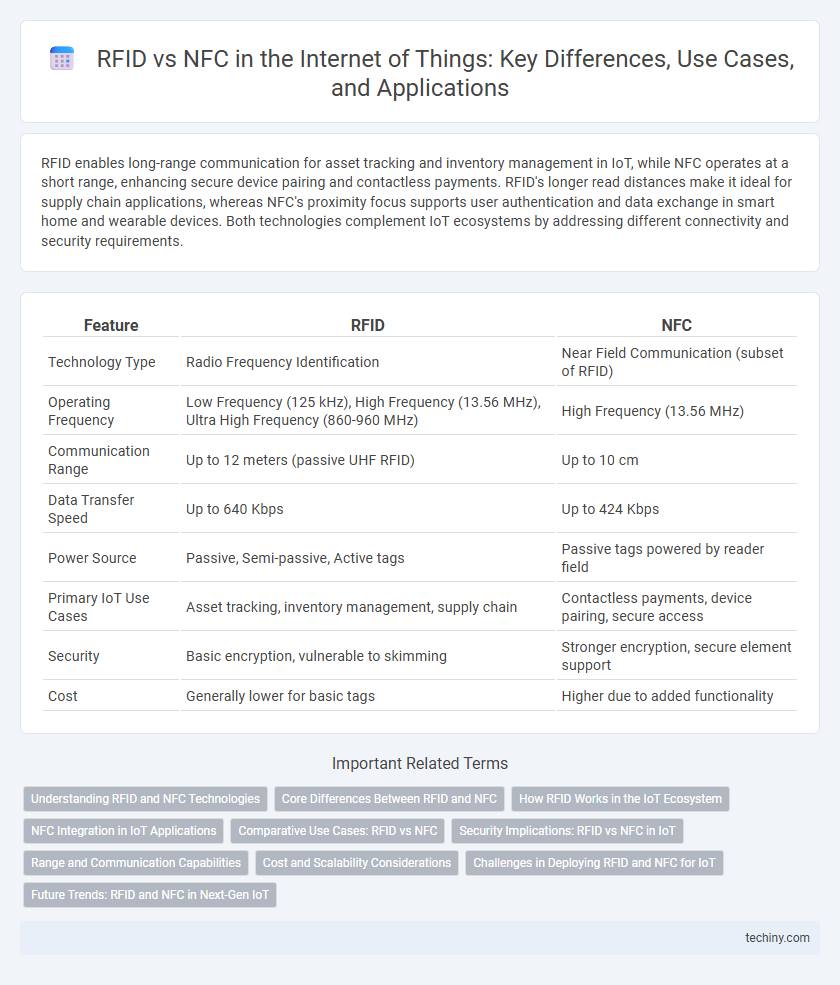RFID enables long-range communication for asset tracking and inventory management in IoT, while NFC operates at a short range, enhancing secure device pairing and contactless payments. RFID's longer read distances make it ideal for supply chain applications, whereas NFC's proximity focus supports user authentication and data exchange in smart home and wearable devices. Both technologies complement IoT ecosystems by addressing different connectivity and security requirements.
Table of Comparison
| Feature | RFID | NFC |
|---|---|---|
| Technology Type | Radio Frequency Identification | Near Field Communication (subset of RFID) |
| Operating Frequency | Low Frequency (125 kHz), High Frequency (13.56 MHz), Ultra High Frequency (860-960 MHz) | High Frequency (13.56 MHz) |
| Communication Range | Up to 12 meters (passive UHF RFID) | Up to 10 cm |
| Data Transfer Speed | Up to 640 Kbps | Up to 424 Kbps |
| Power Source | Passive, Semi-passive, Active tags | Passive tags powered by reader field |
| Primary IoT Use Cases | Asset tracking, inventory management, supply chain | Contactless payments, device pairing, secure access |
| Security | Basic encryption, vulnerable to skimming | Stronger encryption, secure element support |
| Cost | Generally lower for basic tags | Higher due to added functionality |
Understanding RFID and NFC Technologies
RFID (Radio Frequency Identification) and NFC (Near Field Communication) are pivotal IoT technologies enabling wireless data exchange, with RFID offering longer read ranges up to several meters and supporting multiple tags simultaneously, making it ideal for inventory management and asset tracking. NFC operates at a shorter range of about 4 centimeters, facilitating secure, two-way communication typically used in contactless payments, access control, and device pairing within smart environments. Both technologies rely on radio waves but differ in frequency bands, data transfer rates, and application suitability, shaping their roles in diverse IoT ecosystems.
Core Differences Between RFID and NFC
RFID (Radio Frequency Identification) uses radio waves to identify tags from a distance up to several meters, supporting applications like inventory tracking and asset management in IoT. NFC (Near Field Communication) is a subset of RFID with a shorter range, typically under 10 centimeters, optimized for secure, two-way communication such as contactless payments and device pairing in smart environments. Core differences include operational range, data exchange capability, and security features, where RFID offers longer read distances and one-way communication, while NFC enables encrypted, bidirectional data transfer essential for IoT devices requiring secure interaction.
How RFID Works in the IoT Ecosystem
RFID operates in the IoT ecosystem by using radio waves to automatically identify and track tags attached to objects, enabling real-time data collection and asset management. Passive RFID tags receive signals from an RFID reader, which powers the tag and facilitates data transmission without batteries, ideal for scalable IoT applications. This seamless integration supports inventory control, supply chain optimization, and smart asset monitoring, enhancing connectivity and automation across IoT networks.
NFC Integration in IoT Applications
NFC integration in IoT applications enhances secure, short-range communication for seamless device interactions such as smart home automation and contactless payments. Unlike RFID, NFC enables two-way communication, facilitating real-time data exchange and authentication between connected devices. This proximity-based technology supports efficient device pairing and access control, critical for IoT ecosystems requiring secure and intuitive user experiences.
Comparative Use Cases: RFID vs NFC
RFID technology excels in large-scale inventory management and asset tracking within IoT systems due to its longer read range and ability to scan multiple tags simultaneously. NFC, with its near-field communication capabilities, is optimal for secure, short-range applications like contactless payments and device pairing in smart home environments. Both technologies enhance IoT but serve distinct use cases based on range, security, and data exchange requirements.
Security Implications: RFID vs NFC in IoT
RFID and NFC differ significantly in security implications within IoT applications, where RFID's longer read range increases susceptibility to unauthorized scanning and cloning attacks. NFC operates at a close proximity, typically 4 cm or less, enhancing security through limited exposure and enabling secure peer-to-peer communication with encryption protocols. Implementing robust cryptographic measures and mutual authentication in NFC-based IoT devices provides stronger defenses against data interception and spoofing compared to traditional RFID systems.
Range and Communication Capabilities
RFID technology offers a longer communication range, typically up to several meters, making it ideal for asset tracking and inventory management in IoT applications. NFC, with its shorter range of approximately 10 centimeters, enables secure, close-proximity communication suitable for contactless payments and device pairing. Both technologies provide unique advantages in IoT, with RFID excelling in long-range identification and NFC enabling seamless, two-way data exchange.
Cost and Scalability Considerations
RFID systems offer lower costs for large-scale IoT deployments due to inexpensive tags and long read ranges, enabling efficient asset tracking across vast areas. NFC technology, while more costly per unit, excels in short-range communication and secure transactions, making it suitable for personalized IoT applications. Scalability favors RFID for broad inventory management, whereas NFC is optimal for controlled environments requiring close-proximity interactions.
Challenges in Deploying RFID and NFC for IoT
Deploying RFID in IoT faces challenges such as interference from metal and liquids, limited read range, and security vulnerabilities including eavesdropping and cloning attacks. NFC implementation struggles with short communication distance, power limitations for passive tags, and compatibility issues across diverse IoT devices and platforms. Both technologies require robust encryption methods and standardized protocols to ensure secure, efficient integration in complex IoT environments.
Future Trends: RFID and NFC in Next-Gen IoT
RFID technology offers extensive range and asset tracking capabilities crucial for large-scale IoT deployments, while NFC enables secure, short-range communication ideal for consumer IoT devices and payment systems. The future of next-gen IoT envisions hybrid integration of RFID and NFC to enhance interoperability, data exchange efficiency, and real-time analytics across smart cities and industrial automation. Advancements in energy harvesting and ultra-low-power protocols will drive the adoption of RFID and NFC, enabling more sustainable and scalable IoT ecosystems.
RFID vs NFC (IoT use) Infographic

 techiny.com
techiny.com